The following article appeared in the "Stars & Stripes". It was written by 1st Lt. Robert P. Bates, Executive Officer of E Company, 180th Inf. It concerns the assault that E Company made on Hill 290 ( T-Bone ) January 12, 1952.
THE BRAVE MEN GO IN
YOU ARE AN INFANTRY SERGEANT in Korea -- a leader of men whose job is to kill.This is your first test, and you have plenty to do. Going through actions methodically, you give your men their final briefing: Check clothing and equipment, weapons not too oily….might freeze. It's going to be cold, plenty cold.
Clothing check OK. Each man will carry four bandoleers of ammo, plus what is in his cartridge belt. Three hand grenades should be enough, and one rifle grenade per man.
Now sleep…sleep sound.
(12 midnight) A hand shakes you gently and you roll over. Chow time, A heck of a time to eat.
You get up and dress quickly. You have trouble pulling on your shoe pacs because they are frozen. The others are doing the same, very quickly and quietly -- what is there to talk about now?
Chow is fed by platoons. 1st Platoon eats first today. You are in the 2nd, under M/Sgt. Marvin Riddle, 20, Durant, Okla.
Breakfast is scrambled eggs, dry cereal and coffee. You eat outside in the snow, balancing your mess kit on your knees, eating with one hand, bolting your coffee with the other. Don't dare set the coffee down on the frozen ground -- would be cold before you could pick it up.
You're not hungry, but you eat anyway. You'll need the energy later.
Sgt. Sam Buscemi, 25, from Madison, Wis., sits down beside you. You both eat in silence, feeling no need to talk.
SFC James Attaway, Durant, Okla., calls you. Time to get ready. Mess kits washed you make a final check. Won't be long now.
(2 a.m.) … The trucks are here, 15 of them, and 1st. Sergeant Jerald Riddle, Durant, Okla., signals to mount up. The 2nd Platoon gets the second four trucks. All of the men are dressed in parkas now, but they will be left with the trucks when the forward assembly area is reached.
The convoy starts to move. Lt. George H. Parish, Jr., 28, company commander, of Durant, Okla., leads. The trucks move slowly because they are driving under blackout, and the roads are iced over.
Temperature is low…must be below zero. And the men are huddling close together for added warmth. The wind only intensifies the cold, causing your head to ache and the slightest breath is torture to your lungs.
You struggle deeper into your fur lined parka and think.
SUPPORT? All artillery in the division massed; tanks from the regiment's tank company, another Durant unit, and from division reconnaissance company; plenty of mortars borrowed from other battalions, Lots of help.
The convoy rumbles on, gearing down on the hills and picking up speed on the downgrade. The moon is full, casting weird shadows on the mountains that surround you.
Mountains! Everywhere you look, you see mountains, and still the Koreans farm them. You are amazed.
( 3 a.m.) The company finally reaches the forward assembly area. A one-hour trip… pretty good time. Your platoon detrucks and reorganizes itself. Lt. Robert E. Patrick, 21, Mount Sylvan, Tex., and M/Sgt. Frank E. Vanderbilt, 23, Durant, move the 3rd Platoon to the head of the column.
FORWARD OBSERVERS from artillery and mortar join the company and are spotted in the column. You're all set, so you wait. Thirty minutes…an hour. Finally the order is given and you shed your parkas and stack them in squad piles.
Burrr! But it's cold.
The company moves slowly…8,000 yards to walk and then to fight. No need to hurry. The platoon picks its way through barbed wire. The wire has been cut, but the going is still slow.
Stay close to the trails. Mines are on both sides.
You're on the road now, and moving forward…your squad behind you, 10 yards between men. The battalion Communications Platoon, commanded by Lyndel Irby, 30, Durant, has spotted your wire to battalion, and the commo section has picked it up, laying wire as the company moves forward.
The whole company has cleared the barbed wire now and is moving forward slowly. Circulation is coming back to your feet and hands, but the severe cold still bites. The tanks have packed the snow, and the sound of marching sounds like walking over broken china. It doesn't crunch -- it tinkles.
You look around for a sign of friendship, some sigh of acknowledgment. You find none. Each man is buried in his own thoughts, wondering…wondering…intent on doing his job.
Burrr! How cold can it get?
You see M/Sgt. Robert Howard, Durant, with his machine gun section. Each man is laboring under his load of either weapon or ammunition. SFC Lewis Guess, Calera, Okla., and SFC S. C. Buttram, Durant, are his gunners. All good men, you think to yourself.
As the company reaches the attack position, it is halted. Lieutenant Parish makes his final check. Everyone is in position, so the company moves on, past burned out tanks and trucks…sure must have been a battle here at one time.
Again the company halts. You have reached the line of departure, as prescribed by battalion headquarters. The line of departure is a timed point where all action is to begin. The action begins immediately.
NOW OUR ARTILLERY begins to work. Medium, light and heavy mortar artillery goes into action. They hit our objective and points further north, possibly enemy positions and observation posts.
Then as quickly as it started, it quits.
(7 a.m.) The 3rd Platoon moves to the left to take up a support position. Next comes the 1st Platoon under M/Sgt. Vernon Ribera, 24, Boswell, Okla.
The 1st Platoon continues on down the road, followed by the machine-gun section and the 2nd Platoon.
1st and 2nd are to make the assault. The machine-gun section guides to the right to take up its support position in an irrigation canal. The light mortars and recoilless rifles follow the 3rd Platoon to their support position.
(7:15 a.m.) Now it starts. Up you go.
Ice slows you down, but you go up.
Then it hits….automatic fire and rifles. They are shooting at you, and you're scared….plenty scared. You seek cover and locate your men. They're OK. Now you push forward again. More slowly now, cautiously looking for a target.
The machine-guns with Sergeant Howard open up. Thank heavens for that. Still you climb, hurrying your men on, keeping your squad abreast of the other two.
Your own platoon machine-guns are firing now, and the automatic rifles open up. You're halfway up the hill now, Nearing the objective.
Now it happens. Mortars! Enemy mortars. In front, behind and on you. Sergeant Riddle is calling the CO. And you climb, clinging to anything that will half support your weight. All of the fire at your command is directed at the crest of the hill. A trench is dug the entire length of he hill and lead is flying each way -- in and out.
The heavy stuff starts coming in. Durant's Tank Company under the command of Capt. Elmer C. McCord, 33, comes in with strong support. Thank heavens for the tanks
And still you move, Up, up, over the slippery ice, desperately hurrying on. Mortars and small arms threatening to crush you into oblivion. Even in this intense cold you sweat but are not conscious of the fact.
Three men get to the top. they don't stay. Hand grenades!
HOLD UP! The order you half prayed for, half dreaded.
Why? Ribera's platoon is pinned down. He can't move. Caught in a cross fire of machine-guns, small arms and a hail of mortar fire. His radio is out…. no communication.
Now some of his men are falling back. Cpl. Clipper H. Turner, 20. Colbert, Okla., moves through murderous fire to SFC Max Koerner, 22, mortar observer from Durant to tell him what is happening. M/Sgt. Jerry Anderson, 23, Durant, gets the word from Koerner and informs 1st. Lt. Robert P. Bates, Norman, Okla., "Easy" Company executive officer, who is close by. Bates and his radio operator move toward the 1st Platoon. The hail of fire continues to fall.
A general withdrawal is ordered….easier said than done. Raw courage is normal now. Cpl. Robert Shore, 23, Kenosha, Wis., crosses under a hail of lead and hand grenades to get a wounded buddy. Cpl. Keith A. Ayon, 24, an automatic rifleman from Belleview, Wis., covers him. He comes back, mission successful.
Now you start down, carrying the wounded -- and dead. Howard's guns are still firing, moving from time to time to dodge the mortars and packing snow on their red hot guns to keep them firing.
You move your squad to the irrigation canal and start out. PFC. Louis Kutzke, 23, mortar squad leader from Portage, Wis., keeps firing while others move. some don't want to leave… still so mad they are crying unashamed.
The company starts on its way out. PFC. John N. Akers, 22, of Milwaukee, Wis., a 3rd platoon automatic rifleman, is now laying withdrawal cover, now carrying wounded. The small arms fire dies off and your safe. Or, so you think.
Mortars! Those ever-present mortars are following you and you're 6,000 yards from safety. The company keeps moving, So far, the enemy is shooting long, but the are coming in closer….3,000 yards now. Then they hit….one round exploding directly on the road. Two men go down.
You are 500 yards beyond so you keep moving. some of the closer ones goes back. Help is on the way from the aid station, under the direction of 1st Lt. James L. Hobgood, Okemah, Okla. You learn later that the two men weren't killed.
And then, as quickly as it began--it's all over. You're safe.
Back at the assembly area, your squad picks up the parkas and slowly pull them on. You give a silent prayer to God, not only in thankfulness for His sparing you, but for those who weren't as lucky as you--the ones who didn't come back.
[ Note: This action took place 12 January 1952. Six were KIA, Eighteen were
WIA ]
From: "A VERY LONG WEEKEND" by William Berebitsky
MASTER SERGEANT VERNON RIBERA
E COMPANY, 180TH INFANTRY REGIMENT
"Our first company size raid went out on January 12, 1952. We left the MLR about 0200 and very quietly went completely behind Hill 290; we called It T-Bone Hill. We came up the back side of it and jumped off in the attack about 0600. My platoon’s objective was the farthest out and we obviously had the farthest to go. It was two hundred yards to the top of the hill and terribly steep.
The Chinese were dug in at the top and had us at point blank range. They began rolling grenades down on us and bringing in mortar fire from somewhere. Things happened so fast that the next thing I can recall it was about three o’clock in the afternoon. I don’t know what happened to those six or eight hours. I only remember a few things. I know we didn’t make It to the top. One of my men got within ten feet or so before he was killed. I remember seeing him kicking grenades away before a mortar round got him. They gave him the Silver Star.
I know one time my 2nd squad leader and I were lying in a trench, head to head, and he looked up and they shot him right through the mouth. He had a partial plate, but that bullet didn’t hit his partial plate. It hit his good teeth and knocked those out. When I went back to see him in the hospital he said, "Ribera, next time I’m going to let you look up." Sometime in there I got hit too. It may have been at the same time or even the same round that got my squad leader. It was my knee. It barely broke the skin, but It was quite an impact. That was during those eight hours I don’t really remember. We were out there about 300 yards beyond anyone else with about ten men wounded and four men dead. All hell had broken loose. The forward 4.2 mortar observer had a radio but It got shot up and then we had no communications at all. We were to fire a green flare If we needed help evacuating wounded. I had two green flares and neither one of them would work. We felt we were lucky to get out at all.
This Isn’t easy to talk about. You always want to bring your men back If humanly possible. But I did not bring four of my men back. I didn’t want to jeopardize four more, or forty more, to get those four men because I knew they were dead. Whenever a man doesn’t have a head, there’s nothing more you can do for him. That’s hard. I couldn’t bring them back. I tried. The next day they sent out a platoon of tanks to get them and they couldn’t make It either. January 12, 1952. I well remember it because the next day was my birthday and I didn’t know if I was going to live to see it or not."
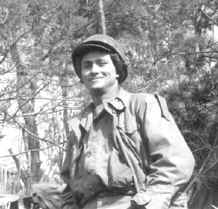
M/Sgt Vernon R. Ribera
M/SGT MARVIN R. RIDDLE
2nd Platoon
E Company’s raid on Hill 290 was the first company size assault of an enemy position by the 45th Division in the Korean War. M/Sgt. Marvin Riddle was the acting platoon leader of the 2nd platoon and was near the top of the hill when strong enemy resistance held up the platoon’s advance.
The Chinese were in fortified positions at the military crest of the hill and were firing small arms, mortars and hurling hand grenades. The only way the platoon could destroy the enemy was by closing with them in the trenches or killing them with hand grenades.
Enemy fire was so heavy that it was impossible to get close enough, in sufficient strength, to do either. Several men got to the top of the hill, but were killed or wounded before they could neutralize the enemy. Heavy casualties limited the platoons effective attack, and the 1st platoon, attacking on the right, had suffered even heavier casualties. 1st Lt. George Parish, the CO gave the order to withdraw.
Sgt. Riddle, complying with the Infantry Soldier’s unwritten rule, to leave no killed or wounded behind, asked for covering fire from the supporting tank in order that he could recover the body of PFC Robert Leighton of Riverside, RI which lay to his front. He relayed a message that he was tying a white handkerchief to the back of his helmet, and asked the tank to keep its machine gun firing just over his head to keep the enemy under cover.
Sgt. Riddle advanced and picked up the body of Robert Leighton, who was a large man and out weighted him by many pounds. Riddle got him over his shoulder and carried him down the hill, stumbling, sliding and falling all the way, while under intense enemy fire. Near the bottom of the hill he was met by medics, who placed both Leighton and Riddle on liters and carried them to the relative safety in an irrigation ditch. While in the ditch he was nearly hit by an artillery shell, which threw him into the air, rendered him unconcious and did permanant damage to his hearing. He recovered in a few minutes, then continued to get his men off the hill and organize them for the withdrawal. The 2nd Platoon recovered all of their dead and wounded.
The irony is that a number of awards were given for bravery, to men who did the same thing as Sgt. Riddle. M/Sgt. Riddle’s act was one of the many throughout the war that went unrecognized, but not forgotten by the men that were with him.
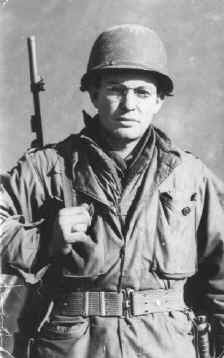
M/Sgt Marvin Riddle
Stars & Stripes
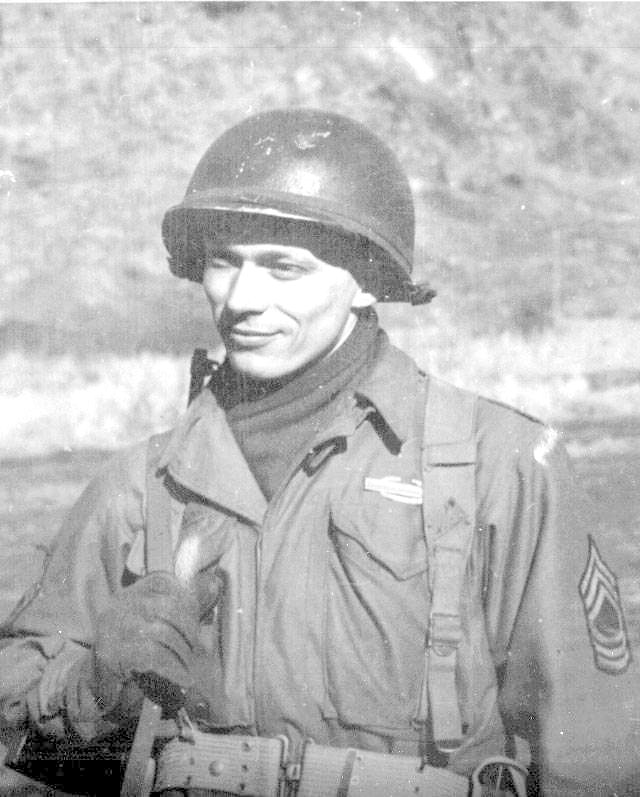
M/Sgt Frank E. Vanderbilt
Platoon Sgt 3rd Platoon
Stars & Stripes
The following was written to Dick Lenagh in February 2001. Dick had asked Jerald Riddle, 1st Sergeant of Easy Company, to recall the attack on Hill 290, 12 Jan 1952.
"Hill 290
Easy Co had just come off the line and was picked to hit Hill 290 in a company size raid. We were to hit it hard and return to our lines. We were having a command change. Capt. Bastista, leaving for new assignment at Corps Headquarters, and Lt. George Parish, the Executive Officer taking over as Commanding Officer. Lt. Parish arranged the deal for the 180th Recon Company to check the valley and he went with them to familiarize himself with the situation and the terrain. The day before the raid I gathered up all the platoon Sgts and Squad Leaders and took them to the jump-off point on the MLR in C Company's area which was in flat country in the river valley, three or 4 miles from the bottom slope of Hill 290.
It was cloudy and you couldn’t see much. Also, our truck broke down and we had only a short time to check it out. The GI’s on line there gave us all the information they knew, but none had been out there. I was not satisfied with the information but it’s all we got. The rest of the men got what ever their Sgt’s told them about it.
The company ate breakfast about 2 am. Pancakes and syrup, sausage and eggs, because the Lt. Parish didn’t think pancakes would last long enough. The order of march was single file with each man holding the coattail of the man in front of him. It was black dark, 12 degrees below zero, and the ground was frozen rock hard.
I was 5th man from the front of the line until we reached the first slope of the hill. Some company, on the MLR had an outpost on a very steep little hill to the left of our line of march, had heard us and were getting nervous. The CO was afraid they would fire on us and told me to go over and talk to them and let them know who we were. I took one man with me and went up that hill with my rifle at sling arms calling out, “E Company-Sgt Riddle-Friendly-2 men from E Co.” They let me get real close before they stopped me. They asked me all kinds of questions, including my CO’s name, his wife’s name and what Highway went through Durant, OK. Then they said, “OK, OK, what do you want?” I waited long enough for it to get light enough to see to get down the hill, and I started back to the outfit.
I got a call from the CO that the 3rd Platoon was moving into a mine field, to contact them if I could, and warn them. He couldn’t reach them. I tried calling them and got an answer but not from the platoon Leader. I gave them the message and never heard from than again but they got out OK. When I got to the company I came under enemy fire and in contact with our wounded about the same time.
I remember having Leighton, who was KIA, taken off a stretcher and Milke, who was hit in the leg and alive, put on the stretcher so he could be carried out first. A messenger from the CO came up and said the CO wanted me to form a rear guard and try to hold the Chinese off long enough for him to get the wounded out. I got the messenger, Johansen, Sgt Guess, a Medic SFC, Mann and a Sergeant I didn’t know. I got a tank to fire on the nearest hill and agree to blowup some extra ammo we were going to leave. The tank was in command of M/Sgt Harris of Tank Co.
About this time I noticed Leighton still lying there. They had not taken him. I picked him up and carried him as far as I could, then the Medic carried him as far as he could. We rested a minute and both carried him some more. Then we turned him on his back and each got a pants leg and dragged him on the ice and snow for about ¼ mile until that track vehicle came back and got him. It had wounded stacked cross ways like cord wood on it. Some passed out, the others shot full of morphine and feeling very little. Milke, I guess got his foot burned on the exhaust.
We went back and started working the rear guard people out two at a time. Guess and his partner went first, they got over the finger, and out of sight OK, then Johansen and I started. The Chinks dropped 3 rounds on us, the first two straddled us, and the last one was high. I was trying to hit the ground when it struck. I lost my helmet and carbine for a minute, and got a face full of ice and dirt. I could get up, walk and move my arms, but I could not talk, breath or see until Johansen cleaned my face and beat me on the back. We had 50 to 100 yards to go to get over the little finger and we made it in one run. They didn’t shoot at us again but they threw three rounds over the finger and hit Guess and Gonzales, a medic. They got out with the tracked vehicle to a helicopter.
It was over loaded and bumped the ground on lift off. Broke the Plexiglas and Guess’s foot was close to the hole in the glass and it froze. He had too much morphine to feel it. It was the same leg that was hit by the mortar. Our artillery returned fire on the mortar and the fight was over.
I went to the 8055 MASH Hospital to see the wounded two days later. Nowatny had his jaw and mouth wired in place and was talking and writing letters for others and giving every one a pep talk.
Jerald Riddle "


E Company withdrawal from Hill 290
Photos by Frank Vanderbilt
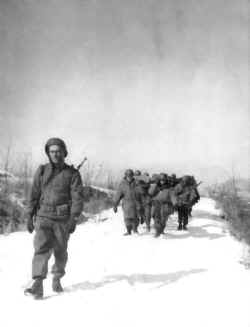
Lt. James L. Hobgood, 180th Graves Registration
Officer
returning with litters from E Company action on Hill 290
Photo by Jack Gunter, 45th Division News
45th Division News
Vol. VII, No 20
EASY COMPANY SWARMS UP RED HILL IN FIRST RAID
The thermometer dipped two degrees below zero while Thunderbirds in Co. E, 180th Infantry, waited to make the 45th Infantry Division's first company-sized raid on a Communist hill.
When the first morning light spread across the valley between UN and Chinese lines, infantrymen started climbing the bunker-infested hill under cover fire from the 45th Recon. company.
The hill was so steep in some places that the men had to pull themselves up with their hands while heavy enemy mortar and small arms fire burst around them. But several men made it to the top and engaged in hand-to-hand fighting.
After a four-hour fight with the Reds, the company withdrew.
Easy company's machine-gun platoon covered the first and second platoons as they climbed the hill, firing over 8,000 round of ammunition during the battle.
"I guess we saw the enemy first," said M/Sgt. Bob Howard, machine-gun platoon leader from Durant, Okla.
"The rest of the company was already under the crest of the hill when we saw three men jump out of their bunkers. We fired at them, and then many more appeared and it looked like they were standing so close together they couldn't move!"
Thunderbirds in Company E probably will remember their first big assignment in combat for many years to come, but 2nd Lt. Robert Patrick, 3rd platoon leader from Mt. Sylvan, Texas, thinks he'll remember it for the rest of his life.
"It was my birthday," he said.
45th Division News
Calling two men
I first met the lieutenant while Easy Company, 180th Infantry, was raiding a Communist-held hill. He was standing on a dirt road which was frozen to the hardness of concrete. "I've got to get back out there." he said. "Three of my men are hurt and I think they're pinned down." A tank idled near the lieutenant. "I'm going out," the tank commander hollered-down to the lieutenant. "Climb on."
The lieutenant joined several men clinging to the outside of the tank just as it started forward on the frozen road which skirts snow-crusted rice fields in no-mans land. Its engines roaring, the tank bounced and jerked up a hill and disappeared down the other side, heading toward the Red hill then under attack.
A couple of hours later, the raiding mission completed, a group of men walked back along that same road, they carried a litter. One of the volunteer bearers was the lieutenant who had gone out to look for three men.
And here is what he told: "I got out in front of where the three men were supposed to be. Someone told me they were trapped in a hut which was being shelled by the Commies. I got permission to go out and try to get them.
"I was about halfway out to the hut when I met a couple of fellows carrying one the wounded back. 'The other two men walked out okay, lieutenant,' the wounded man told me."
But the lieutenant didn't get the rescuer's' names. " I didn't think about names out there." He wants to know who they are, because he figures a couple of medals may be in order."
The lieutenant was James L. Hobgood, Okemah, Okla., graves registration officer for the 180th. "I just went along to help," he explained. "I used to be in Easy company."
45th
Division News
Korea, February 22, 1952
INFANTRY-TANK
PUSH ENDS SILENCE OF SEVERAL DAYS
By LT. PEN WOODS
Several days of comparative silence came to an abrupt end just before dawn when tanks and Infantry of the 180th Infantry blasted at bunkers and ammunition dumps on two enemy-held hills.
Following a two-hour artillery barrage, men of Co. B, 120th Engineers, set off the fuse which began a chain of explosions over a 120-yard pass.
These explosions cleared of mines the opening through which nine tanks of the company charged toward the hills.
At the base of the first hill were more Baker company engineers, supported by a squad of Infantrymen of Co. E 180th, led by Cpl. Claude Cole, Roberta, Okla.
Cole's squad moved down the east flank of the hill, firing at enemy positions and destroying bunkers and ammunition dumps with demolitions.
Other infantrymen and engineers led by Sgt. Sam Buscemi, Madison Wisc., moved by weapons carrier into a rice paddy west of the hill, dismounted and moved toward a small village between the two hills under attack.
Buscemi's squad was pinned down by mortar fire from the second hill until artillery and tanks neutralized the enemy fire.
After four hours of blasting the enemy hills, the tanks, infantry and engineers returned to the lines--all but an engineer tank-dozer, which was bellied on high ground.
A tank retriever from Heavy Tank Company started after the dozer but had engine trouble in no-man's land. A second retriever was unable to remove the dozer.
The dozer was recovered the following afternoon.
(This
action took place at Saemal, North Korea which is just north of Pokkae.
Ernest Heard was wounded in this action.)
45
th DIVISION NEWSVOL. VII, NO.42
KOREA, JUNE 20, 1952
BIRDS TAKE FOUR HILLS AGAINST STIFF OPPOSITION
By NELSON WINTERS
The armed might of the 45th Infantry Division teamed up last week to stage its largest offensive action of the Korean War, capturing four strategic Chinese hills and leaving a "Stockpile" of enemy dead in its path.
Infantrymen of the 180th Infantry and elements of the 179th Infantry advancing behind the division’s heaviest artillery and mortar assault to date, battled their way past strongly fortified enemy positions and repulsed over 20 counter attacks to hold their newly-won ground.
Friendly forces inflicted 1,342 enemy casualties during a five-day period, including 263 known and 453 estimated dead and 626 estimated wounded.
Thunderbird artillery and mortarmen unleashed a continuous shower of steel during the offensive period, pouring over 80,000 artillery rounds and more than 21,000 mortar shells into enemy troops and terrain.
From valley and hillside positions, 180th and 245th Tankers covered the advance with their own barrages.
At the height of the battle, 59 planes zoomed over the battlefront in 15 air strikes, blasting enemy entrenchments with rockets, napalm and 1,000 pound bombs.
When the strikes were completed, more than 163,000 pounds of bombs had been splattered over Chinese held land.
Easy company and Fox company, 180th Infantry, moved toward their objectives simultaneously, the latter storming up the forward slope of the hill while Easy’s forces swept to the rear toward the finger.
Fox company advanced unmolested until they began to ascend the steep hill. Chinese artillery, machine and burp gun fire suddenly rained down upon the Thunderbirds and momentarily halted their push.
Meanwhile, friendly planes swooped over enemy trenches and strafed their "dug-in" positions. Regrouped, Fox infantrymen, employing flamethrowers for the first time in combat, bolted toward the disorganized Chinese and engulfed their bunkers in a mass of flames.
Easy company met stiff resistance after they advanced halfway down a trench line along the finger.
Second Lt. William D. Prichard, 3rd platoon leader, led his men over the first three knolls on the side of the finger and came within 20 feet of a trench when the Chinese "started flipping grenades at us one after the other."
As enemy fire intensified, Prichard’s platoon moved back under cover…Prichard, however was pinned down in a shell crater and was unable to withdraw.
While Cpl. Charles Hamada set up a base of fire with his machinegun from an exposed position. Sgt. George Foster, together with Cpl. Edward Garrett, Pfc. Thomas Humphries and Pfc. Albert Hanson, "leap-frogged" to the stranded lieutenant and covered him until he returned to his troops.
Hanson accompanied the group with only two grenades, which he tossed at the Reds when they stood up to fire.
George Company replaced the weary members of Co. E and continued the fierce firefight against the numerically superior enemy force.
Cpl. Ralph J. Babcock, a machinegunner, and Pfc. James E. Axley, assistant gunner, were perched on a rear slope giving support fire when suddenly a group of soldiers emerged from a bunker wearing GI helmets and uniforms. Other members of the company yelled to the pair to hold fire.
It was not until the soldiers were 30 feet from them did they realize the infantrymen were disguised Chinese.
"Then the lead started to fly," said Babcock "and we got five or six of them before the scrambled back to their bunker."
The Chinese made several futile counterattacks the following night but Charlie Company, 179th, sent them reeling back with heavy losses. Two platoons of Co. K, 179th and two from Co. K. 180th provided security during these engagements.
The next morning Able company 179th, moved passed the captured hill and assaulted another fortified position on the other end of the finger. After a brief but intensive firefight, Able infnatrymen withdrew in the face of heavy shelling.
That afternoon three Thunderbird companies of the 180th "jumped off" in a three-prong attack to take the slope.
Co. K attacked from the left, Co. L from the right and Co. I moved onto the top of the hill which Charlie 179th, successfully defended.
Softened up by another aerial bombardment, the three hill objectives were in friendly hands after a two-hour struggle.
That night a tank-led Chinese battalion staged a midnight attack against the freshly taken hills.
Flares were shot into the sky and indirect lighting from Moonbeam illuminated the area outlining the attacking enemy in the darkness.
Quad 50s, tank and mortar fire from the MLR plastered the enemy while machinegun and small arms fire from the defending troops crackled down upon the Red attackers.
Early reports the next morning from Thunderbird observers said that enemy dead were "stacked up one on top of the other."
A later causality figure counted 180 enemy dead, 175 estimated dead and 200
estimated wounded, as a result of this one-day’s action.
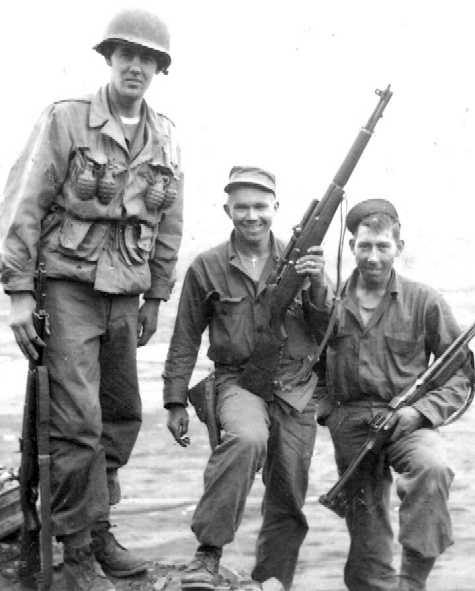
KOREA 1951 - 1953
John Miller, Jr.; Owen J Carroll, Major, U.S. Army
& Margaret E. Tackley
Office of The Chief of Military History
Department of the Army
"
As a result of increased Chinese ground activity at the hinge of the Eight Army's line west of Ch'orwon, Maj. Gen. David L. Ruffner, the 45th Division commander, planned an operation to establish eleven patrol bases across the division's front. If his plan succeeded these bases would screen the division's main line of resistance more adequately by denying the enemy their use. This operation, known as Operation Counter, began on 6 June (1952) when the two front line regiments (180th & 279th) of the division launched a series of attacks to occupy the eleven objectives. By 7 June (1952) all but one objective had fallen to the assault units of the division. The enemy followed up with a series of counterblows during the next five days, but these were successfully repulsed.Seven days later, 13 June, the 45th Division opened Phase II of Counter to seize the last objective, a hill which the 45th had abandoned in March (Eerie). It lay at the southern tip of a T-shaped ridge line eight miles west and slightly north of Ch'orwon. The struggle for the height began with an air strike and a preparatory artillery bombardment. The 2nd Battalion of the 180th Infantry then crossed the line of departure and engaged the Chinese at close quarters. American infantry repulsed four company-size Chinese counterattacks. Next day the regiment's 3rd Battalion relieved the 2nd and secured the objective. U.N. aircraft flew fifty-eight close support missions during the first eighteen hours, and U.N. guns fired 43,600 rounds during the forty-eight hour battle. At noon on 14 June, Phase II of Plan Counter ended with the new chain of patrol bases one to two miles in front of the main line of resistance secure in the divisions hands."
Note: The date 13 June '52 conflicts with the date 12 June as reported in "U.S. Army In The Korean War - Truce Tent and Fighting Front"
TEXT OF
PRESIDENTIAL UNIT CITATION
THIRD BATTALION, 180TH INFANTRY REGIMENT, 45 INFANTRY DIVISION
AND SUPPORTING UNITS FOR ACTION IN KOREA
JUNE 13-14, 1952
(As related by Lt. Charles E. Horn, an observer of the early events of this action.)
The Third Battalion, 180th Infantry Regiment, 45th Division, along with the Forward Observer teams 1, 2, and 3 of Battery C, 171st Field Artillery Battalion, elements of the 180th Regiment Heavy Mortar Co., Medical Company, and other support troops were cited by the President of the United States for outstanding performance of duty and extraordinary heroism in action against the enemy in the vicinity of Tumyong-Dong, Korea during the period June 13-14, 1952. This action was against an entrenched enemy on a steep-sloped hill called Outpost Eerie (Hill 191) on the southern tip of a hill mass called T-Bone Hill. According to topographic maps of the area, Tumyong Dong was a small hill mass just to the southeast of Hill 191, consisting of two twin peaks that had been named "Dagmar" by the troops. The Second Battalion, 180th Infantry, assaulted the objective in the early hours of 12 June after a considerable bombardment by artillery and by 500 pound bombs and napalm from air elements. After an exhausting day of struggle, the Second Battalion was forced to withdraw. The next day (June 13) the Third Battalion was committed to the task. The Presidential Unit Citation stated in part:
"On 13 June, the battalion was assigned the mission of seizing and holding a commanding terrain feature held by a large well entrenched enemy force which, in the preceding 48 hours, had hurled back two attacking friendly battalions with heavy casualties".
"Striking swiftly behind a concentrated friendly artillery barrage, the battalion moved up the slope, fought its way into the enemy trenches, and, in a bitter hand-to-hand struggle, drove the defenders from their positions".
"Acting quickly, the unit then consolidated its gains, preparing hasty fortifications, and establishing a defensive perimeter. With the coming of darkness an intense hostile artillery bombardment was directed against the battalion's positions, over 2500 rounds exploding in the area in one 25-minute period".
"As the bombardments continued, repeated waves of hostile troops charged up the hill and hurled themselves against the friendly defenses".
"Throughout the day of 14 June, 1952, the enemy placed thousands of artillery rounds on the tactically important crest. As evening approached the barrage was increased in intensity and the personnel of the battalion prepared to withstand a second hostile attack".
"In this action the battalion inflicted over two thousand casualties on the enemy, crippling the enemy's potential in the sector, in addition to capturing the important height".
"The Third Battalion, 180th Infantry Regiment, 45th Infantry Division displayed such an extraordinary degree of tenacity and courage in accomplishing its hazardous mission as to set it apart from the other units participating in similar actions".
"The fortitude, aggressiveness, and exceptional fighting spirit exhibited by the members of this battalion throughout this action reflect great credit on themselves and in keeping with the esteemed traditions of the military service".
Hill 334, Location of 2nd Battalion Command OP, 12 June 1952
HQ Co. 1st Bn., 180th Inf.
E Company 12 June 1952
"After an air strike by Fifth Air Force fighter planes and an artillery and mortar barrage on EERIE, E and F Companies, 180th Infantry, under 1st Lt. John D. Scandling and Capt. Jack Tiller, respectively, attacked from southeast against heavy small arms, automatic weapon, artillery, and mortar fire and took the objective. G Company 180th Infantry, quickly moved up under the command of 1st Lt. Richard M. Lee to reinforce its sister companies before the expected enemy counterattack took place. The Chinese came back strongly and casualties were heavy on both sides but the 180th Infantry units hung tenaciously until the enemy broke off the attack." ("Truce Tent and Fighting Front-U.S. Army in the Korean War")
The following information was received from
M/Sgt Allan Jones, 1st Sgt of E Company, who was among the first ones near the top
of the hill and was wounded, so it is not inclusive of the whole
operation on the 12th.
(This information was in a letter Allan written to Odis Starnes and Jerald Riddle
from a hospital in Japan. Allan was finally transferred to
an Army Hospital in Michigan, where he was awarded the Silver Star)
He related that; E Company left the MLR at about 0300, which was much too late. They were to start at 0100 but Love Company, which was to relieve E Company before the attack, had a fight on Uncle with about 100 Chinese.
By the time E Company got to the saddle between Uncle and Yoke it was almost light and it was feared they would be spotted and the Chinese would start engaging them with mortars.
H Company had set up their mortars on Uncle and E Company mortars were placed on Yoke. The H Company mortars were very visible, and the Chinese knocked them out with 2 rounds of 120mm mortar. This eliminated the H Company mortar support from Uncle.
The 1st and 3rd platoons made it to a ditch without being spotted. They stayed in the ditch from 0530 to 0630 when the air support arrived. They dropped eight 1000 lb. and forty eight 500 lb. bombs.
At about 0715 the 1st platoon jumped off in skirmishers. The 3rd platoon followed about 100 yards behind. Lt. Scandling had his OP set up on Yoke and the assault platoons had wire to him.
There was no cover for the 600 yards from the ditch to the hill. The Heavy Mortar Company used their 4.2’s to provided smoke on the south side of 290, which screened E Company perfectly.
The attack had covering fire by 105’s and 155’s, that hit Eerie, 191 and 206 until the 1st platoon was within 100 yards of the enemy positions.
The platoons got to 191 without firing a shot and the Chinese had not yet started firing their mortars.
Hill 206 was a different story, and Fox Company was having a tough time clearing Eerie, the Chinese were dug in and wouldn’t surrender even when grenades were thrown into their holes and didn’t kill them. The holes were not fighting holes, but were dug down from the trenches. You couldn’t walk by the holes because the Chinese inside would cut loose at your legs with burp guns.
On Hill 206 the 1st platoon hit a nest of grenade throwers and were held up, but not pinned down. The grenades had wounded two whole squads, and the 1st platoon requested men from the 3rd platoon.
The Chinese weren’t dug in, but were in a trench on the reverse slope. About 15 of the 1st platoon men were in a skirmish line with no cover. They had to stay out of grenade range and it was fortunate the Chinese didn’t use small arms as they had perfect grazing fire. About every two or three minutes they would stick up their heads for a second to see where the platoon was. They had a 2.36 bazooka, which they fired, but missed.
The platoon called in 57 Recoilless Rifle fire, but it was ineffective. They knew they had to act quickly before the Chinese started firing their mortars. M/Sgt Allan Jones decided to sneak up on the right and try to get them with a grenade. Before he could throw his grenade a Chinese threw a grenade, severely wounding him. He worked his way down to the trench on the extreme south side of Eerie where there were a number of wounded. The Chinese mortar and artillery fire was so intense they were not able to get off the hill until after 10 o’clock.
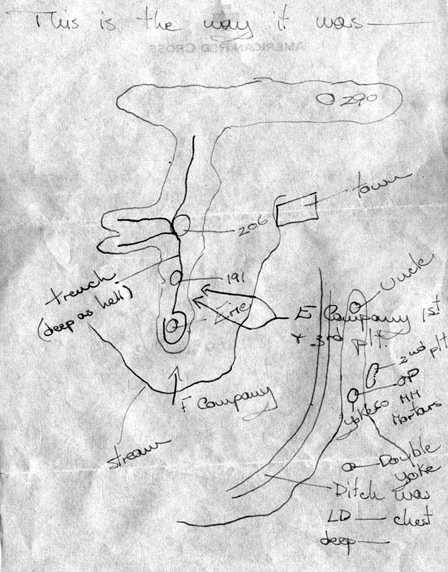
Map was drawn from memory several days after the attack on 12 Jun '52
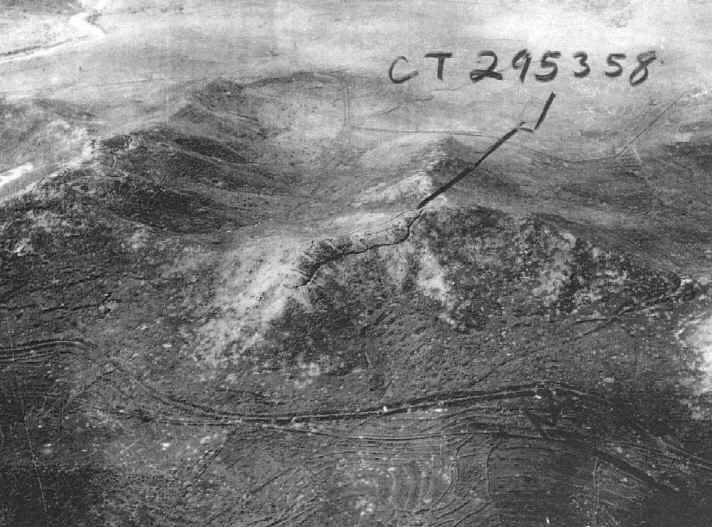
Signal Corps photo of Hill 206, looking South
TWO WEEKS TOO SOON
Charles E. Horn, 1st. Lt., 180th Infantry Regiment
Korea, December 1951-July 1952
Major General James C. Styron was in command of the Oklahoma National Guard 45th Infantry Division (Thunderbirds) when I enlisted as a Private in the National Guard in 1947. He was to command the division after mobilization to Federal service in August, 1950 and on to the occupation of Japan and to combat in Korea in 1951-1952. Mobilization meant that there was a high probability that the division would be called upon to serve in Korea. General Styron clearly assumed a responsibility to respond to duty when called upon, and to assure the survival of as many of his troops as possible. These objectives could be met only by intensive training and by maintaining unit continuity at every level.
Out of at least forty-three National Guard units that were Federalized during the Korean conflict, the 45th Division may have been the only one that was not shamefully stripped of trained cadre personnel to provide replacements to the regular army in Korea. This practice severely impacted the quality and continuity of training of these units, many of which were finally committed to combat without adequate training, equipment, or personnel. Somehow, there was enough political influence in Oklahoma to prevent this disaster from falling upon the 45th, as it did upon the California 40th Infantry Division.
The 40th was committed to Korea shortly after the 45th. The 45th Division was
probably the best trained combat unit to be committed to Korea. It took up a
position along the Jamestown Line guarding the Chorwon-T'son corridor, the main
invasion route to Seoul, in December 1951. The main line of resistance (MLR) had
become somewhat stable when truce talks began at Kaesong in July 1951, was
terminated, then resumed in Panmunjom in October. This
agreed-upon line of demarcation remained reasonably stable at least until mid
1952. During this period there were many sharp encounters, savage attacks and
counterattacks, as both sides probed each other's positions, but there were no
major offensives on either side.
By June, 1952, the 45th had almost fulfilled its mission. The early intensive training had paid off and it appeared that the enemy wanted little further to do with the Thunderbirds. The remaining troops who had been committed to Korean action were within a month of accumulating enough "points" for rotation to the U.S. Beyond that, the term of service for National Guard personnel of the 45th Division would be required by law to end in August of 1952.
From all appearances, the mission of the 45th Division had been achieved. General Styron relinquished his command to Major General David Ruffner on 21 May 1952, no doubt thinking that the division was to very soon be relieved. Most of General Styron's troops would follow soon in rotation, or so he must have thought -- but I am getting ahead of the story.
General Ruffner has been generally blamed for what happened next. He gained
little respect from the troops from the first. Col. Frederick A. Daugherty,
commander of the 179th Infantry Regiment, noted that he was a very critical man
with no combat experience . He went on to relate how he had escorted the general
to a forward position under direct observation of the
enemy. He warned Ruffner that activity in the area would draw artillery and
mortar fire upon his troops. The general conducted his inspection around the
area in plain view of the enemy and that is exactly what happened. Col.
Daugherty noted that he thought, "I'm going to rotate in two or three days
and this silly so and so is going places and doing things he shouldn't be
doing."(1) Col. Daugherty was known to express himself in a gentlemanly
manner. He later became a Major General in command of the 45th Oklahoma National
Guard Division in 1960.
It must have been obvious to Gen. Ruffner that, if his new command is ever to accomplish anything under his command it must be very soon, before most of his commissioned and non-commissioned officers would be rotated home (or before peace talks might end the war). His window of opportunity was only within the 3 weeks after he assumed command.
While forbidden to make any move that could be seen as a major adjustment to the MLR, he devised a scheme that would establish extended outposts along the division front. Eleven objectives were selected, some of which were fortified Chinese positions, with familiar names like "Old Baldy" and "Porkchop Hill". All but one were taken by surprise and held, but with numerous casualties when the enemy launched vigorous counterattacks.
The last objective was called "Outpost Eerie" and a cluster of other nearby hills, located at the near end of a ridge that projected directly toward the MLR from a larger hill mass to the north. This mass was called "T-Bone Hill" and Eerie was a small hill at the southern end of the tail of the bone.
Eerie had been lost to a surprise Chinese assault back in March and the Chinese had made good use of their time to fortify the position. It was obvious that an assault on Eerie would be very costly. The initial task of assaulting this position on 12 June, 1952, fell to the Second Battalion of the 180th Infantry Regiment. Late in the day the assault was reinforced when two platoons of "K" Company of the Third Battalion were committed in relief.
At the time of this assault, I had been replaced as Communication Officer of the First Battalion and was awaiting orders at the regimental rear area for rotation to the U.S. Major Charles T. Caprino, who had been the 180th Infantry Regiment Operations Officer (S3), and who was now commanding the Third Battalion, sent me and a wire line crew, along with telephones, radios, and other equipment that would be needed, to prepare an observation post to be used as his command post. The CP overlooked Eerie across a narrow valley.
The Second Battalion had crossed the line of departure at 0600 on 12 June and, after intensive bombardment by air and artillery, including perhaps thousands of 105mm high explosive (HE) and anti-personnel proximity (VT) rounds and numerous bombing and napalm sorties by close air support, they engaged the enemy. The Chinese emerged from their heavily fortified bunkers and the battle raged all day.
Maj. Caprino manned his CP in the early afternoon, along with his staff, a
Heavy Mortar Co. observer, an artillery FO, and an Air Force close air support
director. At 1615 that afternoon, two platoons of "K" Company crossed
the Line of Departure (LD) and proceeded to secure Outpost Eerie. The battle
raged on into the night. The next day, 13 June, the Third Battalion
attacked in relief of the Second. By the following day, 14 June, all objectives
were secured. Co. G of the Second Battalion and the entire Third Battalion,
along with their supporting units, earned Presidential Unit Citations for their
actions on these dates.
It is a supreme credit to the men who fought these deadly battles when so many of them knew that they were soon due to return home. The "old timers" had been oversees for more than a year and fully expected to soon rotate out of combat. In spite of this, they distinguished themselves and did what was expected of them. Lesser men, at least lesser trained men, would have committed mutiny under these circumstances. Men like these are the ones who created the proud traditions and history of the 45th Infantry Division.
In the month of June, the 45th Division sustained 1004 casualties, including 97 KIA's in the 180th Regiment alone. Nobody even suspected that a year later this same regiment, along with the other division units, would suffer many more casualties at places with names like "Luke's Castle", "Christmas Tree Ridge", "Bethlehem Point", and "Punchbowl", just before the conflict came to an end in July, 1993.
In late June and early July, 1952, after the 180th was relieved and when the
draftees and volunteers who had joined the 45th at Ft. Polk, Louisiana were due
rotation, elements of the regiment were again thrown into the breach to counter
a massive enemy offensive. Again, these men fought with distinction. The
unfortunate events in June of 1952, and perhaps the events of July, might not
have happened if General Styron had not left the scene, probably
believing that the mission of the 45th Division was all but complete(2) . This
thought was likely painful to him in later years. He relinquished his command to
General Ruffner two weeks too soon.
(1) William Berebitsky, A Very Long Weekend, The Army National Guard in Korea, 1950-1953, White Mane Publishing Co., Inc., 1996.
(2) General Styron retired from the National Guard in September 1952, shortly after returning home from Korea, with over thirty-one years service. He died January 2, 1989, at the age of ninety.
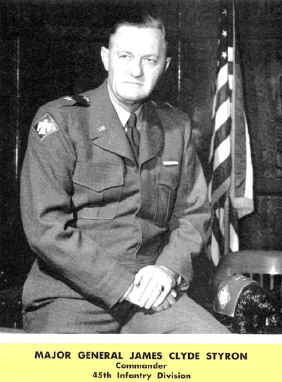
Courtesy Thunderbird Review
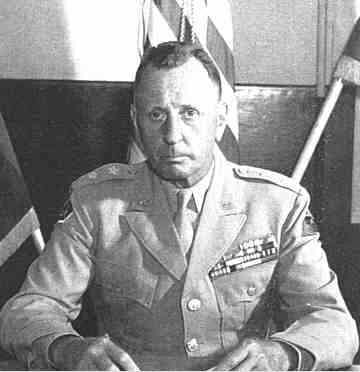
Major General David L. Ruffner
Thurman Ramey
Thurm was a member of the 3rd Platoon. He was the second point man for his squad, but was 2nd Lt. Robert Patrick’s SCR-300 radio operator. He was exposed to a lot of fire when in the open with Patrick, and received a slight shrapnel wound at Hill 290. He was eligible for a Purple Heart, but declined it at the time.
One day he was in the chow line when they were asked if anybody would like to work in the kitchen. Thurm jokingly said that he could cook. Later Mr. Starnes invited him the CP. Thurm at that time told him he was just kidding, he couldn’t cook. Starnes told him that was all right; he probably was as good as some they had at that time.
It turned out the job was to guide and escort the KSCs out to the OPs with hot food. Thurm decided it might be safer than carrying around the radio, with the long antenna, which was a choice target. In that job he became well acquainted with the KSCs, which resulted in many interesting tales.
Dr. Kim
"Dr. Kim was Korean, and a very well educated man. That is why everyone called him doctor. He was in charge of all the KSC's that were attached to our company. When he said jump! They jumped! He would always select those that were to carry ammo, water, mermite cans and anything else that the company needed. He always did this in the most military fashion. Everyone respected his authority and thought this guy was OK.
You probably remember the ammo bunker, the jeep bunker and mess tent were all clustered in the same area. What no one could figure out was how the Chinese had that area so well zeroed in. Almost every day we would get a barrage of artillery.
Jim Seaney was in a bunker upon the ridge line. One night he noticed a very dim light blinking on and off. At first he said he thought it could have been a jeep with those night lights. Then realizing that it was very high up on a hill quite a distance behind us. He alerted one of the Lts. and an ambush was set up the next night behind the line upon that hill where Seaney saw the lights. It was Dr. Kim! He would signal the Chinese when Jeeps, trucks or any thing that would be a good target.
I remembered that event very well, but did not know that it was Seaney that had spotted him until we visited him this past Sept. I can't remember if it was HQ or CIC that came up and got him. I know they were not too gentle with him. Some big square jawed Lt. walked up to him......Dr. Kim started to smile, thinking he was going to be carefully hand cuffed, or something. The Lt. let him have a right hook that almost knocked him out. That was the last I ever heard of Dr. Kim."
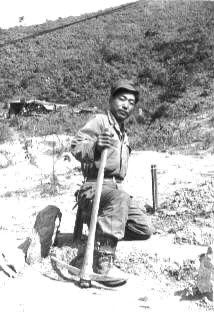
Dr. Kim
Photo: Thurman Ramey
This location was in April ’52. E Company occupied the ridgeline, and had a bridge across the river which went to the 2nd Platoon on "Tank Hill" and 3rd Platoon that was positioned across the valley toward the ROK unit on Arrowhead.
Information and photo supplied by Thurman Ramey.
BUTTER-BALL
"Of all the KSC's, Butter-Ball was one of the best. He never bugged out on anything when things got rough. I know he didn't know anything about Dr. Kim. The look on his face when things surfaced about the Dr. Kim's disloyalty was one of disbelief and anger. He went into a rage when he found out. One of KSC's had been wounded as a result of Dr. Kim. If Butter-ball could have gotten to him, he would have killed him. I found a photo of me and Butter-Ball, I'm the one on the right......(*grin*)"
Thurm
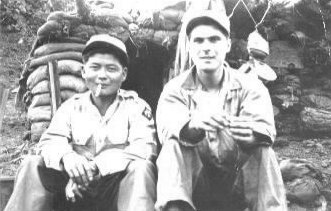
Butter-Ball and Thurman Ramey
THE DIVISION NEWS, KOREA, DECEMBER 28, 1951 VOL VII, NO.17
Reds Wire Holiday Cheer For Explosion
A Company E patrol found. a strange Christmas greeting from the communists last week on the top of a hill in No-Man’s Land.
The Christmas greeting was in the form of a mail box made out of an old ammunition container. Scrawled in red pencil on the side of the box was "Christmas Greetings."
Also on the box was the inscription, "American soldiers, would you write to a buddy in POW camps so that he will get it by Christmas? If so, drop letter in this box and he will get it."
Hanging around the bottom of the box were red and white Christmas stockings.
"We were going to take it back as a souvenir," said Vernon Ribera, platoon sergeant from Boswell, Okla., "until I noticed six wires attached to it and realized it was a booby trap!"
The next day SFC H. D. Merritt, Durant, Okla., led a patrol to the same spot and discovered that the mail box had blown up, leaving a hole in the ground.
In its place was a Christmas tree decorated with communist propaganda.
Note: The 45th Division News was called "Division News" due to the early date. The hill in No-Man’s Land was Pokkae.
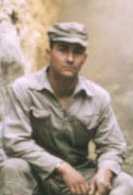
M/Sgt Vernon R. Ribera, Acting Platoon Leader of 1st and 2nd Platoons in
Korea. Awarded the Bronze Star, 4 May 1952.
7 Come 11!
That "Roll" Foretells Good Luck On Patrolling
Missions In Korea For Hamilton Soldier, Buddy
|
WITH THE 45TH INFANTRY Sgt. Jack Akers, Milwaukee, Wis., and Sgt. Eddie Garrett, Hamilton, Ohio, squad leaders in Co. E, 180th Infantry Regiment, brought the dice with them from Japan. Before each patrol, attack or raid they nervously make the lone roll. "If it comes out 7 or 11 or we make our point, that means we’ll come through O.K. If we don’t make our point or roll craps, then we’re in for trouble," said Akers. |
"And for dice haven’t failed us in 30 tries," added Garrett. The pair remembers three occasions last winter when they threw three consecutive craps, and on each patrol their squads fought fierce fights with the enemy. When their missions were completed they got together and talked of their good fortune. Akers shot and killed two Chinese, recaptured an American grease gun, and continued forward 600 yards into no man’s land. When he returned he fired the grease gun and it jammed. Garrett crossed a riverbed and came within 50 yards of a Red platoon. Upon seeing Garrett’s squad, the Chinese withdrew |
without firing a shot. The last time they rolled their "crystal ball" dice, it took the pair almost 10 minutes to make their point. That night their squads went a mile past T-Bone hill into Chinese hills on a patrol and returned hours later unmolested with valuable information. "The only problem now," said Akers, "is which of us is going to keep the dice when we leave Korea." Sgt. Garrett is the son of Mr. Samuel Garrett, 347 S. Fourth St., Hamilton; Sgt. Akers is the son of Mr. And Mrs. Garland Akers, 528 E. Juneau Ave. Milwaukee, Wis. |
HOME / OBJECTIVE
/ EASY ROSTER / 180TH
ROSTER / PHOTOS-KOREA / EVENTS
/ MEMORIAL / PHOTOS- JAPAN
/ LINKS